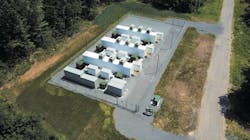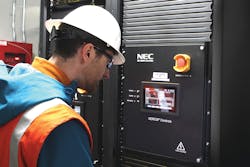Grid-Level Energy Storage Ready for Takeoff but Barriers Remain
For electric utilities like Consolidated Edison Inc.’s subsidiary Orange and Rockland Utilities Inc., battery energy storage is a key component of providing reliable power, but challenges remain for storage technologies as they develop across the United States.
In March 2019, the utility announced it had selected Key Capture Energy LLC (KCE) to plan, design, install and operate a 3-MW battery storage project adjacent to its Ladentown substation in Pomona, New York, U.S., that would enable the utility to delay building costly new infrastructure to accommodate energy use at its peak, which occurs only a few times a year.
MD Sakib, section manager for utility of the future with Orange & Rockland (O&R), said the battery storage project stemmed from the utility’s need for additional infrastructure to provide safe and reliable power alongside rapid load growth in the area. “Rather than building a brand-new substation, by leveraging these distributed energy resource technologies, what we’re doing is we’re deferring the build of brand-new substations for about 10 years or so,” he said.
Battery storage technology like that in O&R’s Pomona project is gaining traction in the industry. Dramatic and recent decreases in pricing, advances in technology and more attention to improving resilience are all factors contributing to the exponential growth in energy storage markets. However, challenges remain for storage technology as it develops across the U.S., including not having enough in-field operational data, getting buy-in at the local level, a lack of sophisticated modeling tools, difficulty in determining the value of storage and the need for wholesale market rules to continue changing to account for the total value that energy storage provides to the grid.
The Biggest Challenge
According to the Energy Storage Association’s (ESA) website: “Energy storage is an enabling technology.”
The website explains that storage augments such resources as wind, solar, hydro, nuclear and fossil fuels as well as demand-side resources and system efficiency assets. It is flexible as it can act as a generation, transmission or distribution asset — or even combine all of these in a single asset.
Energy storage can improve reliability and resilience. For example, it can provide backup power during disruptions as well as smooth out the delivery of variable and intermittent resources such as wind and solar power — by storing excess energy when the wind is blowing and the sun is shining — and delivering it when the opposite is happening, per the ESA website.
Despite these advantages, significant barriers exist that prevent utilities from accessing the full range of benefits, namely participation in energy markets. One reason for this is utilities do not have a firm knowledge yet of how batteries operate in the field, as a result of how relatively new many battery energy storage system (BESS) projects are.
While the industry knows battery energy storage “is going to be a really big part of the clean energy future, there is not much operational data thus far across the United States, as there is less than 1 GW of battery storage installed,” says Jeff Bishop, CEO of KCE.
He added, “There are 50, 60, 70 GW of planned projects” in the interconnection queues, “so that disconnect between what batteries have been tested and proven to do vs. the theoretical and what they might be able to do is the biggest challenge” facing battery storage technology today.
Bishop said KCE approaches this issue by deploying 10- and 20-MW battery storage projects rapidly with laser focus on just a couple of markets so it can be part of the independent system operator’s (ISO’s) working group discussions, for example. The relatively low impact of these projects compared to other major infrastructure projects enables the company to highlight the more streamlined construction process for battery storage installation.
Input at the Local Level
New technologies and new suppliers entering new markets always require a lot of stakeholder discussion and performance analysis to attain buy-in, particularly in the conservative environment in which utilities must operate. “Every technology has its own quirks and, as such, we really have to work in order to understand all the pluses and minuses, and work with our local communities in order to make sure that we mitigate everything we can,” Bishop explained.
O&R’s Sakib echoed that challenges at the local level include informing the various authorities with jurisdiction over battery storage projects — such as local zoning boards — of the different safety mechanisms that the storage technology has and how we can work together to answer any and all questions that the first responders might have.
As of fall 2019, at least three major storage-related fires have occurred in the U.S., including a fire in 2012 that destroyed a 15-MW battery storage facility at a wind farm in Hawaii. For the Ponoma project, Sakib said O&R “brought in industry experts and conducted multiple on-site meetings with the local AHJs, fire department members, volunteers, and first responders to ensure that their outstanding questions were addressed.”
Geoff Brown, president of Powin Energy, the BESS integrator for the Ponoma battery storage project, believes there is a need for dialogue among stakeholders. He said companies like his and others in the storage space need state regulators, for instance, to “be willing to reexamine regulations and rules [and] revenue generation opportunities, to allow for stationary storage assets to do everything that they can do. No state’s electrical generation rules were written with the concept of distributed stationary storage systems sitting at each substation. It’s a fundamentally different way of thinking [of] how do you manage grid-level problems — and we believe it’s, in many cases, going to provide a less expensive and a better service to the customer.”
Modeling Tools Needed
Jeremy Goertz, managing director of SunGrid Solutions — which was selected along with Black & McDonald to provide the engineering, procurement and construction (EPC) and balance of plant (BOP) services for the Ponoma battery project — said another challenge facing battery energy storage technology is the need for “sophisticated modeling and understanding” of the market-based approaches so utilities can maximize the benefits of batteries.
“Batteries can do so many things and are not scripted to just one revenue stream,” Goertz said. “Many independent power producer investors are used to a more singular revenue-streamed-basis approach, such as solar-only projects, and are beginning to see the value through such projects as solar-plus-storage, as is the rest of the market, including utilities, transmission operators and independent system operators.”
He added, “They see the multitudes of opportunities that exist and” the evolution of those modeling tools is challenging.”
Figuring out where the investment makes sense, such as through the distribution line or at the industrial user facility, is key, Goertz noted.
The acceptance of batteries in general — and Lithium-ion batteries, in particular — by financiers and developers as an accepted path has led to a heavy ramp-up of manufacturing, which has “brought down costs substantially, to the point where we’re seeing business cases that every day are making sense” to invest in, Goertz said.
Total Value of Storage
Schuyler Matteson, senior project manager for the New York State Energy Research and Development Authority (NYSERDA), shared that NYSERDA has been focused on the wholesale market and “trying to make sure that the rules in the wholesale market represent the value that storage is actually providing to the market — so making sure that storage can provide capacity services to the New York ISO and be paid for it.”
Similarly, across the country in Oregon, Portland General Electric (PGE) is “exploring the opportunity to co-optimize all the potential value that the storage resource can deliver and gain some learnings from that to figure out what is the total value delivered back to the system over the life of the asset,” according to Darren Murtaugh, PGE’s senior manager for battery storage.
In 2015, legislation passed in Oregon (House Bill 2193) that directed utilities to invest in energy storage. As noted on the Oregon Public Utility Commission’s website, the legislation requires PGE and PacifiCorp to procure one or more energy storage systems by 2020.
Through subsequent negotiations with stakeholders and the commission, “We arrived at a place where we agreed on… five different project types that we’ll be doing — everything from an energy storage project colocated with a generation plant” to a couple of customer-sited projects, Murtaugh said.
The first project slated to be energized is in partnership with the city of Beaverton. The city was planning to build a public safety center and bring its own solar to the table with backup diesel generation, Murtaugh recalled. PGE offered to pair these with a utility-owned energy storage system, namely a 1-MWh battery and microgrid controller, to govern the dispatch of all resources, both grid tied and off grid. In the event of a utility outage, the microgrid controller will decide which resources to use and at what capacity to optimize the energy delivery.
With the microgrid controller, PGE hopes “to reduce or maybe even eliminate the need to run the diesel machines at all,” Murtaugh said.
Discussing challenges facing battery energy storage, Murtaugh, too, expressed a need for safety and “improving our own competency in co-optimizing the economics for energy storage, especially market participation.”
He added, “Here in the Northwest, we don’t have an ancillary services market, but we are recognizing value in flexible resources for our energy portfolio.”
A neighbor of Oregon, California is one of the largest energy storage markets in the world, with about 316 MW of new storage deployed, 3,022 MW contracted or under development, and 3,080 MW of existing storage in the form of pumped hydro, according to California Energy Storage Alliance Executive Director Alex Morris. “[The] long-term trajectory of our market here is that we’ll need tons and tons of energy storage,” Morris said. “We’ll need over 10,000 MW in the next 10 years, which is a lot, and 30,000 MW in the next 20 to 25 years, roughly.”
He noted California is open to batteries of all types, including pumped hydro, compressed air, thermal storage, kinetic storage (like flywheels) and more. “[We] try to create market opportunities that help the grid and then let there be competition among the storage providers to see who’s the best fit,” Morris explained.
Tax Credit Changes
California has long been aggressive with its environmental agenda, having established the first iteration of its renewable portfolio standard (RPS) back in 2002. The state then passed legislation (AB 2514) in 2010 that called for California utilities “to have energy storage as part of our tool kit,” said Morris.
Like others, Morris said the main opportunities for batteries and other types of storage involve such policy enablers as a federal investment tax credit (ITC), which would help support storage deployments for rural areas or urban areas.
ESA CEO Kelly Speakes-Backman also noted a major priority of ESA and the storage industry is to create a level playing field for all clean technologies in the federal tax code. While energy storage currently is only eligible for the federal ITC when paired with solar, “storage can work alongside all types of power resources and often performs as a stand-alone asset to improve grid performance at the transmission or distribution level. The ITC should apply to all energy storage projects, opening up the same support provided to other energy technologies over the years.”
At the state level, utilities have proposed — and regulators have approved — more than 8000 MW of energy storage across the U.S., Speakes-Backman said, adding that wholesale market rules are changing to account for the multiple values energy storage provides to the grid.
While dramatic and recent decreases in pricing, advances in technology and attention to improving resilience are all factors contributing to an exponential growth in energy storage markets over the next several years, she shared that COVID-19 has placed unprecedented stress on the physical and economic health of the energy storage industry.
Among other things, ESA is asking Congress to modify the current ITC to include stand-alone energy storage technologies and allow businesses to monetize them directly, according to Speakes-Backman. She also noted that regulators should establish clear rules for storage deployment, ownership and use; update forecast models in proceedings; streamline interconnection standards; and consider the effects rate design can have on deployment.
O&R’s Sakib believes that as more outreach is done and more people get familiar with battery storage technology, “you’ll see a quick deployment, not just in the commercial space but also in a residential space.”
He added, “Storage is prime for takeoff.”
The industry continues to work through the challenges energy storage presents because, ultimately, it views storage as one of the tools in the tool kit that can help utilities to achieve their goals of delivering clean energy and improving reliability. “The ability to use storage to make sure that clean, zero-carbon resources can provide our [energy] need is really fundamental,” said Jason Doling, NYSERDA’s assistant director of distributed energy resources technology.
He pointed to the need in the downstate region of New York to bring 9 GW of offshore wind onshore and said, “The ability to use longer-duration energy storage…without needing to rely on traditional fossil generation is a huge opportunity that can only grow.”
For More Information:
Black & McDonald | www.blackandmcdonald.com
ESA | https://energystorage.org
Key Capture Energy | www.keycaptureenergy.com
NYSERDA | www.nyserda.ny.gov
O&R | https://oru.com
PacifiCorp | www.pacificorp.com
PGE | www.portlandgeneral.com
Powin Energy | www.powinenergy.com
SunGrid Solutions | www.sungridsolutions.com


